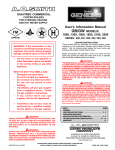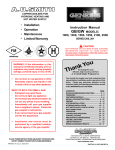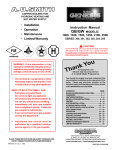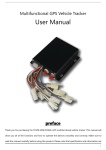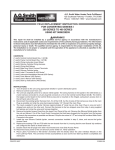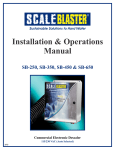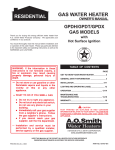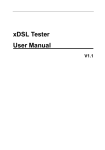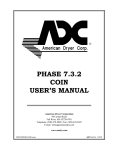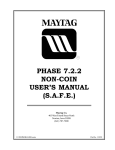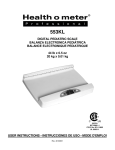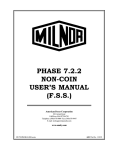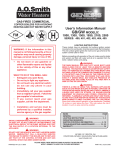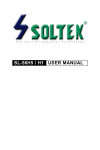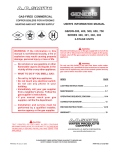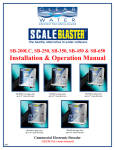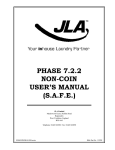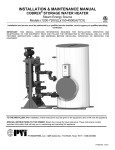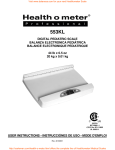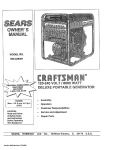Download (211364-000) – PDF - AO Smith Water Heaters
Transcript
GAS-FIRED COMMERCIAL COPPER BOILERS FOR HYDRONIC HEATING AND HOT WATER SUPPLY User's Information Manual GB/GW MODELS: 1000, 1300, 1500, 1850, 2100, 2500 SERIES 200, 201 LIGHTING INSTRUCTIONS WARNING: If the information in this manual is not followed exactly, a fire or explosion may result causing property damage, personal injury or loss of life. • Do not store or use gasoline or other flammable vapors and liquids in the vicinity of this or any other appliance. WHAT TO DO IF YOU SMELL GAS: • Extinguish any open flame. • Do not try to light any appliance. • Do not touch any electrical switch; do not use any phone in your building. • Immediately call your gas supplier from a neighbor's phone. Follow the gas supplier's instructions. • If you cannot reach your gas supplier, call the fire department. • Installation and service must be performed by a qualified installer, service agency or the gas supplier. WARNING SHOULD OVERHEATING OCCUR OR THE GAS SUPPLY FAIL TO SHUT OFF, DO NOT TURN OFF OR DISCONNECT THE ELECTRICAL SUPPLY TO THE PUMP. INSTEAD, SHUT OFF THE GAS SUPPLY AT A LOCATION EXTERNAL TO THE APPLIANCE. These models have an automatic hot surface ignition system mounted on the combustion chamber panel inside the front jacket. This hot surface igniter ignites the main burner gas whenever the system control calls for heat. Before proceeding with operation of the unit, make sure the boiler and system are filled with water and all air is expelled from the boiler, radiator tank(s) and piping. WARNING THE MAIN MANUAL GAS SHUT-OFF VALVE MUST HAVE BEEN CLOSED FOR AT LEAST FIVE (5) MINUTES BEFORE LIGHTING. THIS WAITING PERIOD IS AN IMPORTANT SAFETY STEP. ITS PURPOSE IS TO PERMIT GAS THAT MIGHT HAVE ACCUMULATED IN THE COMBUSTION CHAMBER TO CLEAR. IF YOU DETECT GAS AT THE END OF THE PERIOD DO NOT PROCEED WITH LIGHTING. RECOGNIZE THAT GAS ODOR, EVEN IF IT SEEMS WEAK, MAY INDICATE PRESENCE OF ACCUMULATED GAS SOMEPLACE IN THE AREA WITH A RISK OF FIRE OR EXPLOSION. WARNING THERE IS A RISK IN USING FUEL BURNING APPLIANCES SUCH AS GAS WATER BOILERS IN ROOMS, GARAGES OR OTHER AREAS WHERE GASOLINE AND OTHER FLAMMABLE LIQUIDS ARE USED OR STORED, OR ENGINE-DRIVEN EQUIPMENT OR VEHICLES ARE STORED, OPERATED OR REPAIRED. FLAMMABLE VAPORS ARE HEAVY AND TRAVEL ALONG THE FLOOR AND MAY BE IGNITED BY THE BOILER'S MAIN BURNER FLAMES CAUSING FIRE OR EXPLOSION. Some local codes permit operation of gas appliances if installed 18 inches or more above the floor. This may reduce the risk if location in such an area cannot be avoided. INDEX PAGE GENERAL ........................................................................ 1 LIGHTING INSTRUCTIONS ....................................... 2 - 3 OPERATING SEQUENCE, IGNITION CONTROLS INFORMATION ....................... 4 - 9 MAINTENANCE ...................................................... 10 - 11 WARRANTY .................................................................. 12 WARNING DO NOT USE THIS BOILER IF ANY PART HAS BEEN UNDER WATER. IMMEDIATELY CALL A QUALIFIED SERVICE TECHNICIAN TO INSPECT THE BOILER AND TO REPLACE ANY PART OF THE CONTROL SYSTEM AND ANY GAS CONTROL WHICH HAS BEEN UNDER WATER. PRINTED IN U.S.A. 2527 0601 A DIVISION OF A.O. SMITH CORPORATION EL PASO, TX MC BEE, SC RENTON, WA STRATFORD-ONTARIO, VELDHOVEN-THE NETHERLANDS www.hotwater.com PLEASE KEEP THESE INSTRUCTIONS ADJACENT TO BOILER AND NOTIFY OWNER TO KEEP FOR 1 FUTURE REFERENCE PART NO. 211364-000 REV. 0 Lighting Instructions for the G(B/W) 1000 through 2500 models FOR YOUR SAFETY READ BEFORE OPERATING WARNING: IF YOU DO NOT FOLLOW THESE INSTRUCTIONS EXACTLY, A FIRE OR EXPLOSION MAY RESULT CAUSING PROPERTY DAMAGE, PERSONAL INJURY OR LOSS OF LIFE. C. USE ONLY YOUR HAND TO PUSH IN OR TURN THE GAS CONTROL KNOB. NEVER USE TOOLS. IF THE KNOB WILL NOT PUSH IN OR TURN BY HAND, DON’T TRY TO REPAIR IT. CALL A QUALIFIED SERVICE TECHNICIAN. FORCE OR ATTEMPTED REPAIR MAY RESULT IN A FIRE OR EXPLOSION. A. THIS APPLIANCE DOES NOT HAVE A PILOT. IT IS EQUIPPED WITH AN IGNITION DEVICE WHICH AUTOMATICALLY LIGHTS THE BURNER. DO NOT TRY TO LIGHT THE BURNER BY HAND. B. BEFORE LIGHTING: SMELL ALL AROUND THE APPLIANCE AREA FOR GAS. BE SURE TO SMELL NEXT TO THE FLOOR BECAUSE SOME GAS IS HEAVIER THAN AIR AND WILL SETTLE ON THE FLOOR. WHAT TO DO IF YOU SMELL GAS • DO NOT TRY TO LIGHT ANY APPLIANCE. • DO NOT TOUCH ANY ELECTRIC SWITCH; DO NOT USE ANY PHONE IN YOUR BUILDING. • IMMEDIATELY CALL YOUR GAS SUPPLIER FROM A NEIGHBOR’S PHONE. FOLLOW THE GAS SUPPLIER’S INSTRUCTIONS. • IF YOU CANNOT REACH YOUR GAS SUPPLIER, CALL THE FIRE DEPARTMENT. D. DO NOT USE THIS APPLIANCE IF ANY PART HAS BEEN UNDER WATER. IMMEDIATELY CALL A QUALIFIED SERVICE TECHNICIAN TO INSPECT THE APPLIANCE AND TO REPLACE ANY PART OF THE CONTROL SYSTEM AND ANY GAS CONTROL WHICH HAS BEEN UNDER WATER. E. DO NOT OPERATE APPLIANCE UNLESS UNIT IS FILLED WITH WATER AND WATER LINES ARE FULLY OPEN. OPERATING INSTRUCTIONS 1. 2. 3. 4. 5. 6. 7. STOP ! READ THE SAFETY INFORMATION THE NEXT STEP ABOVE ON THIS LABEL. SET THE SYSTEM CONTROLLER TO THE LOWEST SETTING. TURN OFF ALL ELECTRIC POWER TO APPLIANCE. THIS APPLIANCE IS EQUIPPED WITH AN IGNITION DEVICE WHICH AUTOMATICALLY LIGHTS THE BURNER. DO NOT TRY TO LIGHT THE BURNER BY HAND. REMOVE CONTROL ACCESS PANEL. REFER TO DIAGRAMS ABOVE. TURN TOP KNOB OF GAS CONTROL CLOCKWISE TO “OFF” POSITION, (FIG. A). WAIT FIVE (5) MINUTES TO CLEAR OUT ANY GAS. THEN SMELL FOR GAS, INCLUDING NEAR THE FLOOR. IF YOU SMELL GAS, 8. 9. 10. 11. 12. STOP ! FOLLOW “B” IN THE SAFETY INFORMATION ABOVE ON THIS LABEL. IF YOU DON’T SMELL GAS, GO TO THE NEXT STEP. TURN TOP KNOB OF GAS CONTROL COUNTER CLOCKWISE TO “ON” POSITION, (FIG. B). REPLACE CONTROL ACCESS PANEL. TURN POWER SWITCH TO “ON” POSITION . SET THE SYSTEM CONTROLLER TO DESIRED SETTING. IF THE APPLIANCE WILL NOT OPERATE, FOLLOW THE INSTRUCTIONS “TO TURN OFF GAS TO THE APPLIANCE” AND CALL YOUR SERVICE TECHNICIAN OR GAS SUPPLIER. TO TURN OFF GAS TO APPLIANCE 4. 1. SET THE SYSTEM CONTROLLER TO THE LOWEST SETTING. 2. TURN POWER SWITCH ON APPLIANCE TO “OFF” POSITION. 3. REMOVE ACCESS PANEL TO EXPOSE GAS CONTROL. 5. 2 REFER TO DIAGRAMS ABOVE. TURN TOP KNOB OF GAS CONTROL CLOCKWISE ( TO “OFF” POSITION, (FIG. A). REPLACE CONTROL ACCESS PANEL. Lighting Instructions for the G(B/W) 1000 through 2500 models FOR YOUR SAFETY READ BEFORE OPERATING WARNING: IF YOU DO NOT FOLLOW THESE INSTRUCTIONS EXACTLY, A FIRE OR EXPLOSION MAY RESULT CAUSING PROPERTY DAMAGE, PERSONAL INJURY OR LOSS OF LIFE. A. THIS APPLIANCE DOES NOT HAVE A PILOT. IT IS EQUIPPED WITH AN IGNITION DEVICE WHICH AUTOMATICALLY LIGHTS THE BURNER. DO NOT TRY TO LIGHT THE BURNER BY HAND. B. BEFORE LIGHTING: SMELL ALL AROUND THE APPLIANCE AREA FOR GAS. BE SURE TO SMELL NEXT TO THE FLOOR BECAUSE SOME GAS IS HEAVIER THAN AIR AND WILL SETTLE ON THE FLOOR. WHAT TO DO IF YOU SMELL GAS • DO NOT TRY TO LIGHT ANY APPLIANCE. • DO NOT TOUCH ANY ELECTRIC SWITCH: DO NOT USE ANY PHONE IN YOUR BUILDING. • IMMEDIATELY CALL YOUR GAS SUPPLIER FROM A NEIGHBOR’S PHONE. FOLLOW THE GAS SUPPLIER’S INSTRUCTIONS. • IF YOU CANNOT REACH YOUR GAS SUPPLIER, CALL THE FIRE DEPARTMENT. C. USE ONLY YOUR HAND TO TURN THE MAIN MANUAL GAS VALVE HANDLE. NEVER USE TOOLS. IF THE HANDLE WILL NOT TURN BY HAND, DON’T TRY TO REPAIR IT. CALL A . FORCE OR ATTEMPTED QUALIFIED SERVICE TECHNICIAN. REPAIR MAY RESULT IN A FIRE OR EXPLOSION. D. DO NOT USE THIS APPLIANCE IF ANY PART HAS BEEN UNDER WATER. IMMEDIATELY CALL A QUALIFIED SERVICE TECHNICIAN TO INSPECT THE APPLIANCE AND TO REPLACE ANY PART OF THE CONTROL SYSTEM AND ANY GAS CONTROL WHICH HAS BEEN UNDER WATER. E. DO NOT OPERATE APPLIANCE UNLESS UNIT IS FILLED WITH WATER AND WATER LINES ARE FULLY OPEN. OPERATING INSTRUCTIONS 1. 2. 3. 4. 5. 6. STOP! READ THE SAFETY INFORMATION ABOVE ON THIS LABEL. SET THE SYSTEM CONTROLLER TO THE LOWEST SETTING. TURN POWER SWITCH ON APPLIANCE TO “OFF” POSITION. TURN MAIN MANUAL GAS VALVE TO “OFF” POSITION, (FIGURE “B”). THE VALVE IS “OFF” WHEN THE HANDLE IS PERPENDICULAR TO THE GAS FLOW DIRECTION. THIS APPLIANCE IS EQUIPPED WITH AN IGNITION DEVICE WHICH AUTOMATICALLY LIGHTS THE BURNER, DO NOT TRY TO LIGHT THE BURNER BY HAND. WAIT FIVE (5) MINUTES TO CLEAR OUT ANY GAS. THEN SMELL FOR GAS, INCLUDING NEAR THE FLOOR. IF YOU SMELL GAS. 7. 8. 9. 10. STOP! FOLLOW “B” IN THE SAFETY INFORMATION ABOVE ON THIS LABEL. IF YOU DON’T SMELL GAS, GO TO THE NEXT STEP. TURN MAIN MANUAL GAS VALVE TO “ON” POSITION, (FIGURE “A”), THE VALVE IS “ON” WHEN THE HANDLE IS PARALLEL TO THE GAS FLOW DIRECTION. TURN POWER SWITCH TO “ON” POSITION. SET THE SYSTEM CONTROLLER TO DESIRED SETTING. IF THE APPLIANCE WILL NOT OPERATE, FOLLOW THE INSTRUCTIONS “TO TURN OFF GAS TO THE APPLIANCE” AND CALL YOUR SERVICE TECHNICIAN OR GAS SUPPLIER. TO TURN OFF GAS TO APPLIANCE 1. SET THE SYSTEM CONTROLLER TO THE LOWEST SETTING. 2. TURN POWER SWITCH ON APPLIANCE TO “OFF” POSITION. 3. TURN MAIN MANUAL GAS VALVE TO “OFF” POSITION, (FIGURE “B”). THE VALVE IS “OFF” WHEN THE HANDLE IS PERPENDICULAR TO THE GAS FLOW DIRECTION. 3 The Central Control Board (CCB) is responsible for staging the Ignition Control Boards (ICB) and monitoring safety limit devices, control of circulation pump, power vent (if installed), alarm output and IRI gas valves (only on IRI models). The thermostat also resides on the CCB with inputs available for inlet, outlet and tank temperature probes as well as an input for a remote 24 VAC thermostat. The CCB has a display interface which connects to the Display Board to show system status and failures. The CCB also has a set of DIP switches which allows the user to control several system parameters. (See figure 1.) WARNING THE UNIT SHOULD NOT BE INSTALLED DIRECTLY ON A CARPETED FLOOR. A FIRE HAZARD MAY RESULT. Instead, the boiler must be installed on the A. O. Smith Combustible Floor Kit Base or concrete blocks extending beyond the full width and depth of the boiler by at least 3 inches (76.2 mm). If the boiler is installed in a carpeted alcove, the entire floor must be covered with concrete blocks, or use the A. O. Smith Combustible Floor Kit Base. FLAMMABLE ITEMS, PRESSURIZED CONTAINERS OR ANY OTHER POTENTIAL FIRE HAZARDOUS ARTICLES MUST NEVER BE PLACED ON OR ADJACENT TO THE BOILER. OPEN CONTAINERS OF FLAMMABLE MATERIAL SHOULD NOT BE STORED OR USED IN THE SAME ROOM WITH THE BOILER. Each stage requires an Ignition Control Board (ICB) which is responsible for controlling a combustion blower, hot surface igniter and gas valve. Each ICB is capable of monitoring gas valve power, gas valve relay, flame sense and igniter current. The ICB is designed to communicate with the Central Control Board (CCB). Each ICB consists of identical hardware and software. Each stage ICB is made unique through the use of circuit board jumpers which allow the user to control such variables as stage identification and blower/igniter usage. (See figure 2 for jumper configurations.) These jumpers are preset at the factory and should only be adjusted by a qualified service technician. Light the unit in accordance with the instructions on the lighting and operating label attached to the boiler. These instructions are repeated on the previous two pages. OPERATING CONTROLS INFORMATION The Display Board allows the end user to monitor water temperature, setpoints, differentials, options, fault indications and error codes. Display Board pushbuttons labeled "ADJUST", "SELECT" AND "ENTER/RESET" enable the user to adjust setpoint, differentials, post-circulate time, reset the cycle count and reset the control system during lockout. Changes made to programmable features are stored in nonvolatile memory. MULTI-STAGE FIRING AND CONTROL SYSTEM ALL MODELS - The control system consists of three basic components: 1) Central Control Board 2) Ignition Control Board and 3) Display Board. The Central Control Board and Ignition Control Boards are located in the control box and can be accessed through panels on the left side and top of the unit. The display board is attached to the front jacket panel. The control system is a multistage control capable of managing three or four ignition stages. The number of stages depends on the appliance BTU rating. Three stage models include the 1000, 1300 and 1500. Four stage models include the 1850, 2100 and 2500. Every system will have one Central Control Board, one Display Board and either three or four Ignition Control Boards depending on the model. There will be one Ignition Control Board per stage. Line Polarity Indicator A green LED is mounted on each Ignition Control Board to indicate line voltage polarity is properly connected (see fig. 2). When 120 VAC input power is properly connected to the Ignition Control Board, the green LED will illuminate. If an error is made when connecting 120 VAC input power, this LED will not light. DIP SWITCH CONFIGURATION TABLE SW1 OFF ON SELECTION: A 3 STAGE 4 STAGE EITHER 3 OR 4 STAGE SYSTEM B 3 TRIALS 1 TRIAL EITHER 3 OR 1 C NO IRI GAS VALVE IRI GAS VALVE WHETHER SYSTEM IS IRI OR STANDARD D INLET TANK INLET OR TANK AS CONTROLLING PROBE E NO EXTERNAL EXTERNAL WHETHER EXTERNAL THERMOSTAT THERMOSTAT THERMOSTAT IS USED F OUTLET 210°F OUTLET 240°F OUTLET MAXIMUM TEMPERATURE G 190°F 220°F MAXIMUM INLET SET-POINT TEMPERATURE H DEGREES °F DEGREES °C EITHER °F OR °C FOR DISPLAYED TEMPERATURE ON SW1 12345678 A BCDEFGH Figure 1. Dip Switch Configurations for Central Control Board 4 Figure 2. Jumper Configurations for Ignition Control Board Fuse Protection The 24 VAC circuitry is protected with a 3 amp auto fuse on the Ignition Control Boards and a 5 amp fuse on the Central Control Board. If the fuse opens, a red LED located near the fuse will light (see figures 1 & 2). If the red LED is illuminated, replace the fuse. Repeated failure of the fuse is an indication of possible damage to the ignition control. When power is applied to the Control System, the Display Board will initially run through a self-diagnostic test, and then display the inlet temperature. To display a specific setting or temperature, press the SELECT push-button until the appropriate LED is illuminated (see figure 3). After 5 seconds, the Display Board will automatically revert to displaying the Inlet temperature. Pressing the ENTER/RESET push-button will hold the display in the indicated mode until the SELECT push-button is pressed. Note: Four extra 3 amp fuses and one 5 amp fuse are supplied with the boiler. Recommended Replacement fuses: 3 Amp: Littlefuse automotive fuse PN 257003 5 Amp: Bussman Automotive fuse PN ATC5 With the display board, the user can make adjustments to many of the appliance’s control features. This includes the following: DIA-SCAN II DISPLAY BOARD OPERATING PROCEDURES • Set Appliance Stage Temperature Setpoint Value The Display Board provides a user-friendly interface to the Central Control Board. With the Display Board, the user can control appliance functions and view the overall operating status of the appliance. If an error condition occurs, the Display Board will indicate the nature of the fault by illuminating a red LED. The display will further define the fault by illuminating a red LED corresponding to the stage on which the fault has occurred. Each stage has both a red and green LED associated with it to indicate either a fault or normal operation. If the fault continues until the unit "locks out", the display will show a three digit code in addition to the red LEDs. (See Table 1 for error code chart.) Under normal operating conditions, the four digit LED display on the Display Board will continuously show the water temperature sensed at the inlet temperature probe. If dip switch "D" on the Central Control Board is placed in the "ON" position, it will show the temperature at the tank probe. (See Figure 1.) The push buttons on the Display Board allow the user to program and view several system parameters described in the following text. The Display Board is connected to the Central Control Board through a 6 conductor cable assembly with modular plug terminations. In addition, an 8 conductor modular jack on the Display Board allows for connecting a remote display board. • Set Appliance Stage Switching Differential Value • Select Appliance Post-Circulate Time • Check Appliance Cycle Count • View Last Error Encountered by Control • Control the water temperature in a storage tank Options/Features Setting Procedures Green Status Lights Green LEDs indicate when a given stage has sensed flame and is in the heating state. They also are used to indicate when the Set-Point differential for a given stage is being viewed or adjusted. (See Figure 3.) STAGE 1: Stage One in Operation STAGE 2: Stage Two in Operation STAGE 3: Stage Three in Operation STAGE 4: Stage Four in Operation 5 Figure 3. Display Board Red Fault Lights The Red LEDs are illuminated to show faults and help in trouble shooting. There are three faults (High Gas Fail, LWCO and Power Vent Fail) listed as "Optional" which are only functional when the particular "Optional" equipment is connected to the boiler. The red stage LEDs indicate the stage on which a given fault has occurred. (See figure 3.) *Defaults to tank probe temperature when Dip Switch "D" on Central Control Board is Switched to the "ON" position. (See Figure 1.) TEMPERATURE PROBES All units come with two temperature probes connected to the Inlet/ Outlet header. Additionally, an optional tank probe (thermistor type) or 24VAC thermostat/aquastat can be connected to the unit. The probes can be categorized as two types: controlling probes and safety limit probes. Controlling probes can control the staging of the boiler. Safety limit probes are used as resettable high limit switches. The two controlling probes are the inlet probe and the tank probe. The function and setting of the probes is further described in the following sections. Blocked Flue: Blockage in Flue Probe Fail: One of the controlling Probes has failed Insufficient Air: Not enough Air to Close Switch Circulate Fail: Flow Switch Not Closed Gas Valve Fail: Relay for Gas Valve in Incorrect State High Limit: High Limit has been Exceeded Flame Fail: No Flame Sensed on Ignition Igniter Fail: Igniter did not reach Minimum Amperage Outlet Probe The Outlet Temperature/ECO probe is located on the left side of the header and has two sets of wires embedded in it. The black wires sense the temperature at the probe. Their output is shown on the display screen when the "OUTLET" LED is illuminated. The red wires control the ECO (Emergency Cutoff) which shuts down the unit if the water temperature exceeds 250°F (121°C) and requires a manual reset of the boiler. The outlet probe functions as a automatically resettable high limit and is not considered a controlling probe on the boiler, which means it cannot be set to control the staging of the unit. Depending on the application of the boiler, the probe is set to one of two settings. In GW applications, the maximum Outlet Set Point is 210°F (99°C) and in GB applications it is 240°F (115°C). The Outlet probe Set Point can be adjusted between these two values using Dip Switch "F" on the Central Control Board inside the control box. (See figure 1.) Low Gas Fail: Gas Pressure too low to Close Switch High Gas Fail: Gas Pressure at Manifold too High LWCO: Low water Cutoff activated. Not enough water in system. Power Vent Fail: Not Enough Air to Close Switch Stage One: Failure on Stage One Stage Two: Failure on Stage Two Stage Three: Failure on Stage Three Stage Four: Failure on Stage Four Yellow Parameter Set Lights The five yellow parameter set lights allow the user to view system set points and options. In conjunction with the four green stage LEDs, the user can monitor and change settings on the various stages. (See Figure 3.) Inlet*: Outlet: Set-Point: Set-Point Differential: Standby: Temperature shown is Inlet Water Temperature. Temperature shown is Outlet Water Temperature. Indicates controlling probe setpoint is being displayed. Shows differentials of each stage. Indicates Set-Point is Satisfied. Boiler in Idle State. To view the current programmed temperature set-point for the Outlet Temperature probe: 6 1. Press the SELECT push-button on the display board until both the Set-Pt LED (see figure 3) and Outlet Water Temperature LED (see figure 3) are illuminated. 2. The LED display will show the current set-point temperature. Encase field-supplied wires between tank probe and junction box with 1/2" field supplied conduit. "Pigtails" of fieldsupplied wires should be spliced to "pigtails" of tank probe and connected to 24VAC junction box. This conduit and wiring should be separate from any other conduit/ wiring to guard against EMI (electromagnetic interference). Figure 4. Tank Probe Installation Tank Probe (Optional) In additon to the Inlet and Outlet/ECO Probes, units can be optionally equipped with a tank Probe. The connection for the tank probe is located in the 24 VAC junction box at the rear of the unit. The tank Probe can be configured to control the staging of the unit. See Tank Probe Installation section below for additional information. Note: Under no circumstances should the Outlet/ECO be set to exceed 210°F (99°C) in applications where the boiler is heating potable water. Failure to observe this will void the warranty. Inlet Probe The Inlet probe is located on the right side of the Inlet/Outlet header. It has one set of blue wires embedded in it which senses the temperature at the probe. The Inlet Probe is considered a controlling probe and can be used to control the staging of the unit. The inlet probe set-point is fully adjustable between the factory set minimum value of 80°F (25°C) and a user controlled maximum value which will depend on the unit's application. In GW applications, the maximum Inlet Set-Point is 190°F (88°C) and in GB application it is 220°F (104°C). The Inlet probe Set-Point can be adjusted between these two maximum values using Dip Switch "G" on the Central Control Board which is located inside the control box. (see figure 1.) TANK PROBE INSTALLATION PROCEDURE (GW Models) A tank probe is supplied with each hot water supply boiler (GW). To connect the tank probe to the boiler, remove the cover from the 24 VAC junction box at the rear of the unit. Connect the probe wires across terminals 1 & 2. (The wires leading to the terminals will be yellow.) Check the field connection diagram located below the junction box to assure proper wiring. See figure 4. Once the tank Probe has been connected to the boiler, it must be designated as the controlling probe for the system. This is accomplished by changing two Dip Switch settings on the Central Control Board. First, Dip Switch "D" must be set to the "ON" position to designate the tank probe as the controlling probe. Second, Dip Switch "G" must be set to the "OFF" position to limit the maximum tank probe temperature for GW applications. It is also advisabe to make sure Dip Switch "F" is set to the "OFF" position which sets the Outlet temperature Set-Point to 210°F (99°C). If the tank probe is not designated as the controlling probe, the staging of the unit will be controlled by the Inlet Probe and will not use the desired tank temperature as its base. Once the tank Probe is designated as the controlling probe, the Inlet Water Temperature on the display will default to the tank temperature. To change or view the current programmed temperature set-point for the Inlet Temperature probe value: 1. 2. 3. 4. 5. 6. 7. Press the SELECT push-button on the display board until both the Set-Pt LED (see figure 3) and Inlet Water Temperature LED (see figure 3) are illuminated. The LED display will show the current set-point temperature. Press and hold the ADJUST push-button. The displayed temperature will either increase or decrease. To alternate between increasing or decreasing the temperature, release then press and hold the ADJUST push-button. When the desired set-point temperature is reached, release the ADJUST push-button. Press the ENTER/RESET push-button once, this enters the selected set-point temperature into controller memory. The appliance will now control the temperature to the desired set-point value. For setting the stage differentials, see the section labeled Procedure for Setting Stage Differential. Refer to the (figure 4) for connecting the tank probe to the boiler. Procedure for Setting Tank Probe Temperature The user can easily change or view the water temperature set-point at any time by using the following procedure: 1. The boiler must complete a full cycle in order for the new setting to take effect. If the unit is turned off prior to a complete cycle the setting will be lost and the previous setting will remain in effect. 2. 3. 24 VAC System Controller (Optional) A 24 VAC thermostat/aquastat can be implemented as a system controller on Genesis units. The connection for such devices is located in the 24 VAC junction box at the rear of the unit. A 24 VAC thermostat/aquastat can only be used as an "On/Off" switch for the unit. The actual controlling of the staging will be through either the inlet or tank probe. To use a 24 VAC system controller, dip switch "E" on the CCB must be switched to the "on" position. See figure 1. 4. NOTE: 5. 6. 7. 7 Press the SELECT push-button on the display board until both the Set-Pt LED (see figure 3) and Inlet Water Temperature LED (see figure 3) are illuminated. The LED display will show the current set-point temperature. Press and hold the ADJUST push-button. The displayed temperature will either increase or decrease. To alternate between increasing or decreasing the temperature, release then press and hold the ADJUST push-button. When the desired set-point temperature is reached, release the ADJUST push-button. Press the ENTER/RESET push-button once, this enters the selected set-point temperature into controller memory. The appliance will now control the temperature to the desired set-point value. For setting the stage differentials, see the section labeled Procedure for Setting Stage Differential. Procedure for Setting Stage Differentials Procedure for Setting Pump Delay Once the system control and set-point temperature has been entered, the switching differentials for the staging of the unit must be established. To facilitate proper operation and maximize appliance performance, each stage has a programmable switching differential or “hysteresis” about the set point. This means a call for heat for a particular stage will become active when the water temperature measured at the controlling temperature sensing probe drops to the set-point value minus the switching differential value. It is necessary to set three set-point differential values for three stage units and four for four stage. The burner will remain on until the water temperature measured at controlling probe reaches the stage set-point value. The switching differential value is fully programmable from 0°F to 20°F (0°C to 11°C) using the push-button(s) located on the Display Board. The Controller is factory set with a 45 second post circulate function. With the Display Board, the user has the capability to choose between a 45, 90, or 180 second post circulate time period, or turn the pump on continuously. This provides flexibility in selecting the post circulate time to meet specific installation requirements, and improves the efficiency of the circulating pump operation. To change or view the current programmed post-circulating time: 1. 2. 3. 4. To change or view the current programmed switching differential: 1. 2. 3. 4. 5. 6. 7. Press the SELECT push-button on the display board until both the Set-Pt Diff. and green Stage One LED are illuminated. See figure 3. The LED display will show the current differential for stage one. Press and hold the ADJUST push-button. The displayed value will either increase or decrease. To alternate between increasing or decreasing the differential, release then press and hold the ADJUST push-button. When the desired Set-Pt differential is reached, release the ADJUST push-button. Press the ENTER/RESET push-button once, this enters the selected set-point differential into controller memory. To view the Set-Pt minus the Set-Pt differential, press and hold the "ENTER" push-button. This will be the "turn-on" temperature for Stage One and the "turn-off" temperature for Stage Two. Repeat steps 2 through 5 for the rest of the stages. The appliance will now control temperature utilizing the desired differentials. 5. 6. Press the SELECT push-button on the Display Board until the LED display reads "OP" (Options). See figure 3. To enter into the options mode, press the ENTER/RESET pushbutton. The display will illustrate "Crcu". Enter this mode by pressing the ENTER/RESET push-button. The display will now illustrate the current post circulate time. Press the ADJUST push-button to select the desired post circulate time (45, 90, 180, "con"). When you have selected the desired post circulate time mode, press the ENTER/RESET push-button once, this enters the selected post circulate time into controller memory. The display will automatically return to illustrating the controlling probe temperature after five (5) seconds. Last Error Code In this mode, the Display Board will illustrate the last error which caused the unit to "lock-out". When this mode is entered the three digit failure code that was in memory last will be displayed. (See Table 1 for error codes.) For example, if the appliance "locked-out" due to insufficient air on stage one, the display will show 041. To enter into this mode, perform the following steps: 1. 2. 3. Example: Application: Hydronic Heating Desired System Temperature: 185°F (85°C) Stage Differentials: 5°F (3°C) per Stage 4. 5. Note: The user must choose which probe is to control the staging of the unit. The controlling probe will be either the inlet or tank probe. (If the tank probe is used to regulate loop temperature in hydronic applications (GB), make sure it is located on the return side of the closed loop.) Use Dip Switch "D" on the Central Control Board to make this selection. See figure 1. Press the SELECT push-button on the display board until the LED display reads "OP" (Options). See figure 3. To enter into the options mode, press the ENTER/RESET push-button. The display will illustrate "Crcu". Press the SELECT push-button until the display illustrates "Ler". Enter this mode by pressing the ENTER/RESET push-button. The display will illustrate the last error detected by the control. The display will automatically resort to illustrating the controlling probe temperature after five (5) seconds. Display Stage Cycle Count The Central Control Board counts the number of cycles each stage of the appliance has operated by counting how many times the gas valve(s) are energized. To check the cycle count for each stage, perform the following procedure: Set the stage differentials using the procedure described in the Procedure for Setting Stage Differential section of the document. Setting the control as described in the above example (5°F differentials for each stage) will give the following stage set-points. 1. 2. 3. Stage One Off Temperature: 185°F (85°C) On Temperature: 180°F (82°C) Stage Two Off Temperature: 180°F (82°C) On Temperature: 175°F (79°C) Stage Three Off Temperature: 175°F (79°C) On Temperature: 170°F (77°C) Stage Four Off Temperature: 170°F (77°C) On Temperature: 165°F (74°C) 4. 5. 6. 8 Press the SELECT push-button on the display board until the LED display reads "OP" (Options). See figure 3. To enter into the options mode, press the ENTER/RESET push-button. The display will illustrate "Crcu". Press the SELECT push-button until the display illustrates "CC". Enter this mode by pressing the ENTER/RESET push-button. The display will now illustrate the current number of cycles stage one has fired. Notice that the green Stage One LED is illuminated. Pressing the ENTER/RESET button again will cause the green Stage Two LED to illuminate and the cycle count for stage two will be displayed on the screen. Cycle counts for the other stages can be viewed in a similar fashion. To reset the cycle count to zero, press the ADJUST push-button. Press the ENTER/RESET push-button to successfully reset the cycle count. If the ENTER push-button is not pressed, the reset function will not be saved and the original cycle count will continue to increment on each gas valve operation. The display will automatically return to illustrating the controlling probe temperature after five (5) seconds. DANGER Appliance Operating Sequence 1. 2. 3. 4. 5. 6. 7. 8. 9. HOT WATER TEMPERATURES REQUIRED FOR AUTOMATIC DISHWASHER AND LAUNDRY USE CAN CAUSE SCALD BURNS RESULTING IN SERIOUS PERSONAL INJURY AND/OR DEATH. THE TEMPERATURE AT WHICH INJURY OCCURS VARIES WITH THE PERSON'S AGE AND TIME OF EXPOSURE. THE SLOWER RESPONSE TIME OF CHILDREN, AGED OR DISABLED PERSONS INCREASES THE HAZARDS TO THEM. NEVER ALLOW SMALL CHILDREN TO USE A HOT WATER TAP, OR TO DRAW THEIR OWN BATH WATER. NEVER LEAVE A CHILD OR DISABLED PERSON UNATTENDED IN A BATHTUB OR SHOWER. When power is applied to the control system, the Display Board will initially run through a self-diagnostic routine, and then go into its operating mode, displaying the temperature sensed at the controlling probe. This can be either the inlet or tank probe. If the ignition control determines the actual water temperature at the controlling temperature probe is below the programmed temperature setpoint minus the switching differential, and the thermostat circuit or tank probe circuit is closed, a call for heat is activated. The control then performs selected system diagnostic checks. This includes confirming the proper state of the ECO/High Limit device, flow switch*, and pressure switches. *Note: Correct water flow is vital to the operation of the boiler. See the Installation manual for requirements on flow, head loss and heat exchanger pressure drop. If all checks are successfully passed, the circulating pump circuit is energized. Once the flow switch has closed, all combustion blowers will energize for a 30 second pre-purge cycle. When the pre-purge cycle is complete, all blowers except stage 1 will drop out. Power is then applied to the stage 1 ignitor element for the ignitor warm-up period. The control will verify ignitor current. After the verification, the gas valve will open, allowing gas to enter the burner. After an additional 1 second, the control will monitor the flame sensing probe to confirm a flame is present. If a flame is not verified within 4 seconds, the gas valve is immediately closed. The control will initiate a 15 second inter-purge period and return to step 2, unless dip switch "B" is in the "ON" position, in which case it will proceed to "lockout". If a flame is confirmed, stage two will be activated. The blower associated with stage two (if applicable) will start. Once the blower has been proven, igniter two will begin its warm-up period. (This is true on all units except the 1000 which has only one igniter.) After the igniter current has been proven, stage two will begin a trial for ignition. Stage three will activate after flame is proven on stage two. If applicable, the blower associated with stage three will begin. Once the blower has been proven, a trial for ignition will begin on stage three. If flame is not proven, there will be a 15 second interpurge on stages with an associated blower. The boiler will then begin additional trials for ignition. On stages without an associated blower, a five second delay will occur before the gas valves are opened for additional trials for ignition. THE WATER HEATER SHOULD BE LOCATED IN AN AREA WHERE THE GENERAL PUBLIC DOES NOT HAVE ACCESS TO SET TEMPERATURES. It is recommended in domestic hotwater applications that lower water temperatures be used to avoid the risk of scalding. It is further recommended, in all cases, that the water temperature be set for the lowest temperature which satisfies the user's hot water needs. This will also provide the most energy efficient operation of the boiler and minimize scale formation in the heat exchanger, thus prolonging the life of the boiler. SETTING THE WATER HEATER TEMPERATURE AT 120°F (49°C) WILL REDUCE THE RISK OF SCALDS. Some states/provinces require settings at specific lower temperatures. Table 2 below shows the approximate time-to-burn relationship for normal adult skin. TABLE 2. Risk of Scalds Note: Stages on which no blower or igniter is present will bypass the blower and igniter proving periods. The gas valves will open five seconds after a call for heat is initiated on the stage. Temperature Setting Time to Produce 2nd & 3rd Degree Burns on Adult Skin Over 170°F (77°C) 160°F (71°C) 150°F (66°C) 140°F (60°C) 130°F (54°C) 120°F (49°C) or less Nearly instantaneous About 1/2 second About 1-1/2 seconds Less than 5 seconds About 30 seconds More than 5 minutes USE ANTI-SCALD VALVE(S) in the hot water system to reduce the risks of scalding at points of use such as lavatories, sinks and bathing facilities. 10. Once all of the stages have been satisfied, the pump will run for the programmed post-circulate cycle (factory default 45 seconds). See circulating pump adjustment procedure in the installation manual. 11. The control now enters the idle state. This is indicated on the display by the "Standby" LED. The control will continuing to monitor temperature and the state of other system devices. If the water temperature at the designated system controller drops below the setpoint value minus the switching differential, and the thermostat circuit or tank probe circuit closes, the control will return to step 2 and repeat the entire operating cycle. During this idle state, if the control detects an improper operating state for external devices such as the ECO switch, air pressure switch, gas pressure switch, etc., the appropriate red LED(s) on the Display Board will illuminate indicating the nature of the fault. TROUBLESHOOTING IGNITION SYSTEM The control system has several features to aid in troubleshooting problems which may occur during operation. If a fault occurs, the Display Board contains sixteen (16) red fault LED indicators to help pinpoint the source of failures. In addition, the display will inform the user on which stage the failure occurred by illuminating a red Stage LED. In cases where the problem persists to lockout, the appropriate red LEDs will remain illuminated and a three digit error code will flash on the display screen. A summary of error codes is given in Table 1. The error codes are broken into two categories: hard lockouts and soft lockout. 9 Hard Lockouts: Hard lockouts require a manual reset accomplished by pressing the Enter/Reset push-button on the display board. Cycling the power "OFF" and "ON" will not reset the control. MAIN BURNERS Check main burners every three months for proper flame characteristics. The main burner should display the following characteristics: Soft Lockouts: Soft Lockouts also require a manual reset accomplished by pressing the Enter/Reset push-button on the display board. However, under a soft lockout condition, the control will re-initiate an ignition process after one (1) hour provided the call-for-heat is still present and will continue every hour until the unit is either reset or ignites. • Provide complete combustion of gas. • Cause rapid ignition and carry over of flame across entire burner. • Give reasonably quiet operation during initial ignition, operation and extinction. • Cause no excessive lifting of flame from burner ports (see fig. 5). A description of the red fault LEDs and their corresponding functions are as follows. Also refer to figure 3. LED Controller Function Blocked Flue Indicates a blockage or interference at the appliance flue. Temp. Probe Fail Indicates failure at one of the temperature probes. Unit will "lockout" only if controlling probe fails. Insufficient Air Indicates air pressure was too low to create a sufficient differential to close the differential pressure switch. Figure 5. Burner Flame Characteristics If the preceding burner characteristics are not evident, check for accumulation of lint or other foreign material that restricts or blocks the air openings to the burner or boiler. Circulate Fail Indicates water flow was too low to close the flow switch. Gas Valve Fail Monitors Gas Valve relay output. LED is ON when the output relay supplying power to the gas valve(s) is open. 1. Remove main burners from unit. High Limit Monitors ECO in the Outlet Temperature probe. LED is ON when the ECO is open. 3. Clean burners with bristle brush and/or vacuum cleaner. DO NOT distort burner ports. Flame Fail Monitors the Flame Sense Rod. LED is ON when a signal from the flame rod is not sufficient to indicate flame. 4. Reinstall burners in unit. Ensure that all the screws on the burner flange are tightened securely so that the gasket will provide a good seal. Also, ensure that each orifice is centered with the venturi opening of every burner. Igniter Fail Indicates igniter current was too low to meet minimum value which allows trial for ignition to continue. Make sure the washer of each pre-jet orifice is inserted at least 1/4 into the burner tube and that it is not touching the sides of the burner tube. This is critical for proper operation. See fig. 6. Low Gas Fail Inlet gas pressure is not sufficient to close gas pressure switch. High Gas Fail* Manifold gas pressure has exceeded designed maximum value. LWCO Fail* Indicates water level in system is too low for safe operation. Power Vent Fail* Air pressure at Power Vent Switch is not sufficient for safe operation. NOTE: Cleaning of main burners. Shut off all gas and electricity to unit. 2. Check that burner venturi and ports are free of foreign matter. 5. Check for good flow of combustion and ventilating air to the unit. *Optional Equipment - LEDs will illuminate only if equipment is connected to boiler. Upon lockout, manually push the ENTER/RESET button on the display panel to restart the boiler. Figure 6. Burner/Orifice Insertion 10 After placing the boiler in operation, check the ignition system safety shut-off devices for proper operation. To accomplish this with the main burners operating, close the valve on the manifold. Within four seconds the main burners should extinguish. If this does not occur immediately, discontinue gas supply by closing main manual shut-off and call a qualified serviceman to correct the situation. If the burners extinguish, then light boiler in accordance with lighting and operating instructions. The usage of water softening equipment greatly reduces the hardness of water. However, this equipment does not always remove all of the hardness (lime). For this reason it is recommended that a regular schedule for deliming be maintained. The time between cleaning will vary from two to six months depending upon water conditions and usage. A change of approximately 5°F (3°C) in the normal temperature rise through the boiler is usually an indication that scale should be removed. For long life, copper or brass is recommended for all valves, pipe and fittings. For installations above 4500 feet (1350 m), refer to HIGH ALTITUDE INSTALLATIONS in the installation manual. DO NOT STORE COMBUSTIBLE MATERIALS, GASOLINE, OR OTHER FLAMMABLE VAPORS, LIQUIDS IN THE AREA OF THE APPLIANCE. NONCOMPLIANCE MAY RESULT IN FIRE OR EXPLOSION. DO NOT OBSTRUCT THE FLOW OF COMBUSTION OR VENTILATION AIR TO THE APPLIANCE. CAUTION LIME ACCUMULATION CAN REDUCE THE LIFE OF THE EQUIPMENT, REDUCE EFFICIENCY AND WASTE FUEL. BOILER FAILURE DUE TO LIME OR SCALE BUILDUP VOIDS THE WARRANTY. CHEMICAL VAPOR CORROSION COMBUSTION AIR BLOWER Boiler corrosion and component failure can be caused by airborne chemical vapors. Spray can propellants, cleaning solvents, refrigerants, calcium or sodium chloride (water softener salts), waxes, chlorine and process chemicals are typical compounds that are potentially corrosive. These materials are corrosive at very low concentration levels with little or no odor to reveal their presence. Products of this sort should not be stored near the boiler. Air which is brought in contact with the boiler should not contain any of these chemicals. The boiler should be provided with air from outdoors when installed in environments having corrosive atmospheres. The bearings in the motor are pre-lubricated and sealed at the factory. The bearings should be oiled once every six months per the manufacturer's recommended maintenance schedule. Use SAE-29 non-detergent oil. RELIEF VALVE The safety relief valve should be opened at least twice a year to check its working condition. This will aid in assuring proper pressure relief protection. Lift the lever at the top of the valve several times until the valve seats properly and operates freely. CIRCULATION PUMP Refer to the pump manufacturer's schedule of maintenance for frequency and method of lubricating the pump and motor. Inspect the pump once a month for leaky mechanical seals and/or O-rings and loose or damaged components. Contact a qualified service agent to replace or repair parts as required. BLOCKED VENT SHUT-OFF SYSTEM The boiler is equipped with a blocked vent shut-off system which will close the gas valve and shut off the main burner gas when there is excessive pressure pressuring the vent system due to a partially or completely blocked vent. The display on the front panel will indicate this failure condition. DO NOT ATTEMPT TO OPERATE THE BOILER if this situation occurs. Shut the boiler off before performing all the steps shown in "TO TURN OFF GAS TO APPLIANCE" section of the Lighting and Operating Instructions. Contact a qualified service agent to inspect the unit and vent system and correct the problem. VENT SYSTEM The flue products are corrosive in nature and if the boiler is vented horizontally the flue gases are at a higher pressure than the surrounding air pressure. Inspection of the boiler and vent system is necessary to insure that flue gas leakage to the surrounding area does not occur. Inspect the external surfaces of the vent system every 6 months for corrosion and leakage. Inspect the vent terminations for corrosion and foreign matter (including ice) which may be blocking the exhausting flue products. Call a qualified service agent to replace or repair any corroded or leaking parts. Qualified service agent must inspect internal surfaces of the vent system and the boiler at least once a year. DELIMING The amount of calcium carbonate (lime) released from water is in direct proportion to water temperature and usage. The higher the water temperature or water usage, the more lime deposits are dropped out of the water. This is the lime scale which forms in pipes, boilers and on cooking utensils. TABLE 1. Error Codes 11 NEW BOILER LIMITED WARRANTY A. O. Smith Corporation, the warrantor, extends the following LIMITED WARRANTY to the owner of this hydronic boiler: 1. If within TEN years after initial installation of the boiler, the heat exchanger shall prove upon examination by the warrantor to be defective in material or workmanship, the warrantor, at his option, will exchange or repair such part or portion. This term is reduced to FIVE years if this boiler is used for volume hot water supply purposes other than hydronic space heating. a. This warranty is extended to the owner for all other parts or portion during the FIRST year following initial installation of this boiler. b. The warranty on the repair or replacement of the part or portion will be limited to the unexpired term of the original warranty. 2. CONDITIONS AND EXCEPTIONS This warranty shall apply only when the boiler is installed in accordance with local plumbing and building codes, ordinances and regulations, the printed instructions provided with it and good industry practices. In addition, an appropriately sized safety relief valve certified to the ASME Boiler and Pressure Vessel Code must have been installed and fresh water used for filling and makeup purposes; a. This warranty shall apply only when the boiler is used: (1) at temperatures not exceeding the maximum setting of its operative and/or high limit control; (2) at water pressure not exceeding the working pressure shown on the boiler; (3) when filled with boiler water, free to circulate at all times and with the heat exchanger free of damaging scale deposits; (4) in a noncorrosive and non-contaminated atmosphere; (5) in the United States, its territories or possessions, and Canada; (6) at a water velocity flow rate, not exceeding or below the Boiler's designed flow rates; b. Any accident to the boiler, any misuse, abuse (including freezing) or alteration of it, any operation of it in a modified form will void this warranty. 3. SERVICE AND REPAIR EXPENSE Under this limited warranty the warrantor will provide only a replacement part. The owner is responsible for all other costs. Such costs may include but are not limited to: a. Labor charges for service removal, repair or reinstallation of the component part; b. Shipping, delivery, handling, and administrative charges for forwarding the replacement part from the nearest distributor and returning the claimed defective part to such distributor. c. All cost necessary or incidental for any material and/or permits required for installation of the replacement. 4. LIMITATIONS ON IMPLIED WARRANTIES Implied warranties, including any warranty of merchantability imposed on the sale of this boiler under state law are limited to one (1) year duration for the boiler or any of its parts. Some states or provinces do not allow limitations on how long an implied warranty lasts, so the above limitation may not apply to you. 5. CLAIM PROCEDURE Any claim under the warranty should be initiated with the dealer who sold the boiler, or with any other dealer handling the warrantor’s products. If this is not practical, the owner should contact: U.S. Customers A. O. Smith Water Products Company 5621 West 115th Street Alsip, IL 60803 Telephone: 800 323-2636 a. b. 6. Canadian Customers A. O. Smith Enterprises Ltd. P. O. Box, 310 - 768 Erie Street Stratford, Ontario N5A 6T3 Telephone: (519) 271-5800 The warrantor will only honor replacement with identical or similar parts thereof which are manufactured or distributed by the warrantor. Dealer replacements are made subject to in-warranty validation by warrantor. DISCLAIMERS NO OTHER EXPRESS WARRANTY HAS BEEN OR WILL BE MADE ON BEHALF OF THE WARRANTOR WITH RESPECT TO THE BOILER OR THE INSTALLATION, OPERATION, REPAIR OR REPLACEMENT OF THE BOILER. THE WARRANTOR SHALL NOT BE RESPONSIBLE FOR WATER DAMAGE, LOSS OF USE OF THE UNIT, INCONVENIENCE, LOSS OR DAMAGE TO PERSONAL PROPERTY OR OTHER CONSEQUENTIAL DAMAGE. THE WARRANTOR SHALL NOT BE LIABLE BY VIRTUE OF THIS WARRANTY OR OTHERWISE FOR DAMAGE TO ANY PERSONS OR PROPERTY, WHETHER DIRECT OR INDIRECT, AND WHETHER ARISING IN CONTRACT OR TORT. a. Some states or provinces do not allow the exclusion or limitation of the incidental or consequential damage, so the above limitations or exclusions may not apply to you. b. This warranty gives you specific legal rights, and you may also have other rights which vary from state to state or province to province. Fill in the following for your own reference. Keep it. Registration is not a condition of warranty. The model and serial number are found on the boiler’s rating plate. Owner______________________________________________________________________________________________________________________ Installation Address________________________________________________________________________________________________________ City and State or Province ___________________________________________________________________________________________________ Date Installed ___________ Model No. ___________________________ Serial No. ____________________________ Dealer’s Name______________________________________________________________________________________________________________ Dealer’s Address__________________________________________________________________Phone No. ________________________________ FILL IN WARRANTY AND KEEP FOR FUTURE REFERENCE 5621 W. 115TH STREET, ALSIP, IL 60803 Phone: 800-433-2545 Fax: 800-433-2515 www.hotwater.com E-Mail: [email protected] REPLACEMENT PARTS 12












